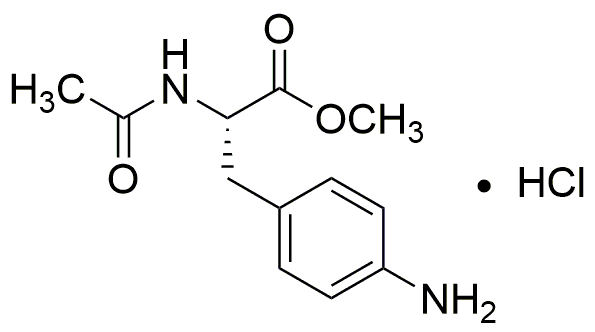Acetyl-4-amino-L-phenylalanine methyl ester hydrochloride is widely utilized in research focused on:
- Pharmaceutical Development: This compound serves as a building block in the synthesis of peptide-based drugs, particularly in the development of analgesics and anti-inflammatory medications.
- Biochemical Research: It is used in studies related to neurotransmitter function and can help in understanding the mechanisms of various neurological disorders.
- Protein Engineering: Researchers employ this compound to modify proteins, enhancing their stability and activity, which is crucial in biotechnology applications.
- Diagnostic Tools: It plays a role in the development of diagnostic assays, particularly those targeting amino acid metabolism, aiding in the detection of metabolic disorders.
- Academic Research: This compound is a valuable reagent in academic laboratories for teaching purposes and in experimental setups to illustrate amino acid properties and reactions.
General Information
Properties
Safety and Regulations
Applications
Acetyl-4-amino-L-phenylalanine methyl ester hydrochloride is widely utilized in research focused on:
- Pharmaceutical Development: This compound serves as a building block in the synthesis of peptide-based drugs, particularly in the development of analgesics and anti-inflammatory medications.
- Biochemical Research: It is used in studies related to neurotransmitter function and can help in understanding the mechanisms of various neurological disorders.
- Protein Engineering: Researchers employ this compound to modify proteins, enhancing their stability and activity, which is crucial in biotechnology applications.
- Diagnostic Tools: It plays a role in the development of diagnostic assays, particularly those targeting amino acid metabolism, aiding in the detection of metabolic disorders.
- Academic Research: This compound is a valuable reagent in academic laboratories for teaching purposes and in experimental setups to illustrate amino acid properties and reactions.
Documents
Safety Data Sheets (SDS)
The SDS provides comprehensive safety information on handling, storage, and disposal of the product.
Product Specification (PS)
The PS provides a comprehensive breakdown of the product’s properties, including chemical composition, physical state, purity, and storage requirements. It also details acceptable quality ranges and the product's intended applications.
Certificates of Analysis (COA)
Search for Certificates of Analysis (COA) by entering the products Lot Number. Lot and Batch Numbers can be found on a product’s label following the words ‘Lot’ or ‘Batch’.
*Catalog Number
*Lot Number
Certificates Of Origin (COO)
This COO confirms the country where the product was manufactured, and also details the materials and components used in it and whether it is derived from natural, synthetic, or other specific sources. This certificate may be required for customs, trade, and regulatory compliance.
*Catalog Number
*Lot Number
Safety Data Sheets (SDS)
The SDS provides comprehensive safety information on handling, storage, and disposal of the product.
DownloadProduct Specification (PS)
The PS provides a comprehensive breakdown of the product’s properties, including chemical composition, physical state, purity, and storage requirements. It also details acceptable quality ranges and the product's intended applications.
DownloadCertificates of Analysis (COA)
Search for Certificates of Analysis (COA) by entering the products Lot Number. Lot and Batch Numbers can be found on a product’s label following the words ‘Lot’ or ‘Batch’.
*Catalog Number
*Lot Number
Certificates Of Origin (COO)
This COO confirms the country where the product was manufactured, and also details the materials and components used in it and whether it is derived from natural, synthetic, or other specific sources. This certificate may be required for customs, trade, and regulatory compliance.


